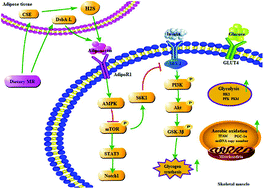Dietary methionine restriction improves glucose metabolism in the skeletal muscle of obese mice†
Abstract
Dietary methionine restriction (MR) has many positive effects on metabolic health. Recent studies have indicated that overall insulin sensitivity is improved by dietary MR. This study aimed to determine the effects of MR on insulin signalling and glucose utilisation in the skeletal muscle of obese mice. First, male C57BL/6J mice in the CON group were fed a control diet (0.86% methionine + 4% fat) for 34 weeks, and others were fed a high-fat (HF) diet (0.86% methionine + 20% fat) for 10 weeks to induce obesity. Then, the mice were divided into four dietary groups: the HF group (maintained on the HF diet), HF + MR group (0.17% methionine + 20% fat), C* group (changed to a control diet, 0.86% methionine + 4% fat), and C* + MR group (0.17% methionine + 4% fat) for 24 weeks. Mice were euthanised at 8, 16 or 24 weeks. The results indicated that MR ameliorated obesity-induced hyperglycaemia and hyperinsulinemia. Moreover, MR up-regulated the gene expression of disulfide-bond A oxidoreductase-like protein and cystathionine-γ-lyase and promoted adiponectin and H2S production in inguinal white adipose tissue. Furthermore, MR activated AMP-activated protein kinase and inhibited its downstream signalling and up-regulated insulin signalling-related molecules in gastrocnemius muscle. Overall, MR improved glucose metabolism via increasing glycogen synthesis, glycolysis, and aerobic oxidation. Interestingly, most parameters were equivalent between the HF + MR group and C* + MR group. These findings suggest that dietary MR can improve glucose metabolism in obese mice.



 Please wait while we load your content...
Please wait while we load your content...